The Fushimi Inari Taisha shrine in Kyoto, Japan, is renowned for its spiritual significance and captivating visual appeal. Visitors can enjoy a profound Shinto experience by partaking in the shrine’s Prayer and Kagura ritual. Guided by a priest, participants engage in purification rites and traditional offerings, culminating in a mesmerizing Kagura performance. This unique experience not only offers a glimpse into Japan’s rich religious heritage but also allows visitors to connect with the serene and ethereal atmosphere of the shrine.
Key Points
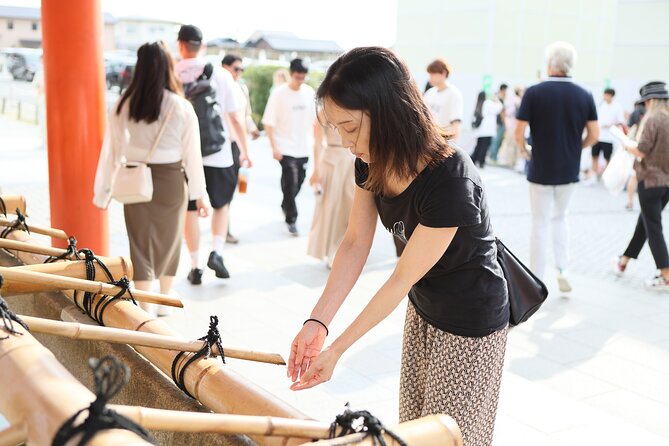
- Visitors can participate in a traditional Shinto prayer ceremony at Fushimi Inari Taisha, where they learn proper hand motions, bowing, and incantations.
- The prayer ceremony allows for offerings and blessings, creating a meaningful and authentic experience for visitors.
- The Kagura performance, a captivating Shinto ritual dance, marks the culmination of the Fushimi Inari Taisha experience.
- The Kagura dance is performed by trained priests with graceful movements and rhythmic chanting to invoke deities.
- Fushimi Inari Taisha offers wheelchair and stroller accessibility, and visitors are advised to avoid large luggage for ease of navigation.
Overview of Fushimi Inari Taisha

Fushimi Inari Taisha is an iconic Shinto shrine located in Kyoto, Japan.
It’s renowned for its thousands of vibrant orange torii gates that wind through the sacred mountain. The shrine is dedicated to Inari, the Shinto god of rice, fertility, and industry.
Visitors can explore the mountain trails, passing by numerous smaller shrines and statues.
Fushimi Inari Taisha is one of Kyoto’s most popular attractions, drawing visitors from around the world to experience its spiritual atmosphere and stunning scenery.
It’s a must-see destination for anyone visiting Kyoto, offering a glimpse into Japan’s rich cultural heritage.
You can also read our reviews of more tours and experiences in Kyoto.
Significance of Shinto Rituals
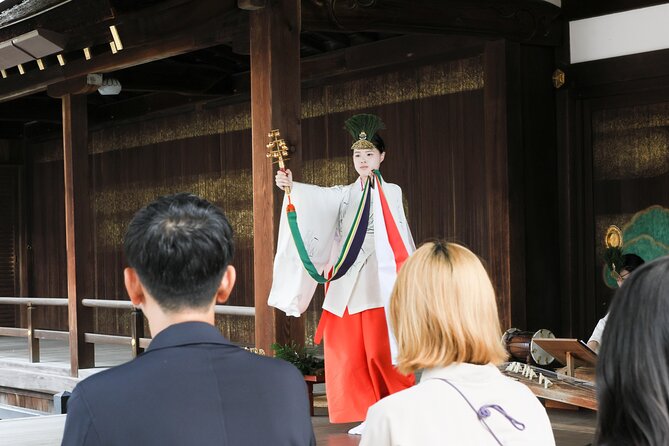
Shinto rituals play a significant role in the experience of visiting Fushimi Inari Taisha.
During the tour, visitors participate in a traditional prayer ceremony and witness a Kagura performance, which are sacred Shinto rituals. The prayer ceremony allows participants to make offerings and ask for blessings, connecting them to the shrine’s spiritual essence.
The Kagura dance, performed by a Shinto priest, is a ritual dance that invites the kami (deities) to descend and bless the participants.
These rituals immerse visitors in the rich cultural and religious heritage of Fushimi Inari Taisha, creating a truly meaningful and authentic experience.
The Prayer Experience
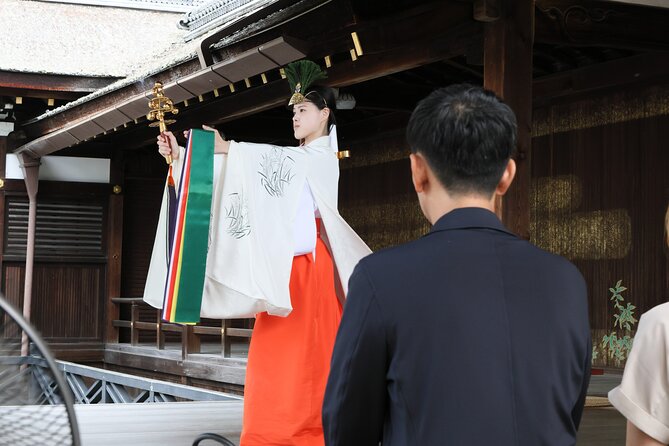
During the Fushimi Inari Taisha experience, visitors are guided through a traditional Shinto prayer ceremony. They learn to perform the proper hand motions, bowing, and incantations under the supervision of a Shinto priest. This sacred ritual allows participants to make offerings, express gratitude, and seek blessings from the kami (divine spirits).
| Step | Action | Purpose |
|---|---|---|
| 1 | Purify hands and mouth | Cleanse body and mind |
| 2 | Bow twice, clap twice, bow once | Show respect and humility |
| 3 | State prayer and make offerings | Communicate with kami |
The prayer experience culminates with the Kagura dance, a performative ritual that invites the kami to the shrine.
Kagura Performance Highlights
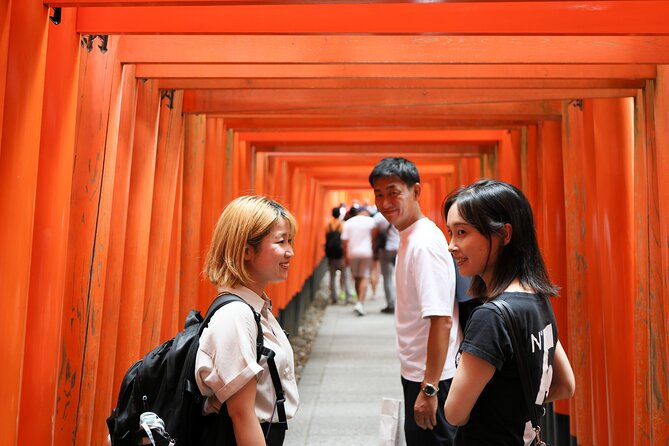
The Kagura performance marks the culmination of the Fushimi Inari Taisha experience, captivating visitors with its intricate choreography and spiritual significance.
This ancient Shinto ritual dance is performed by trained priests, who invoke deities through graceful movements and rhythmic chanting.
Guests will witness the powerful dedication and concentration of the performers as they engage in this sacred practice.
The Kagura isn’t merely a performance but a means of connecting with the divine, offering a profound and authentic cultural experience within the hallowed grounds of the shrine.
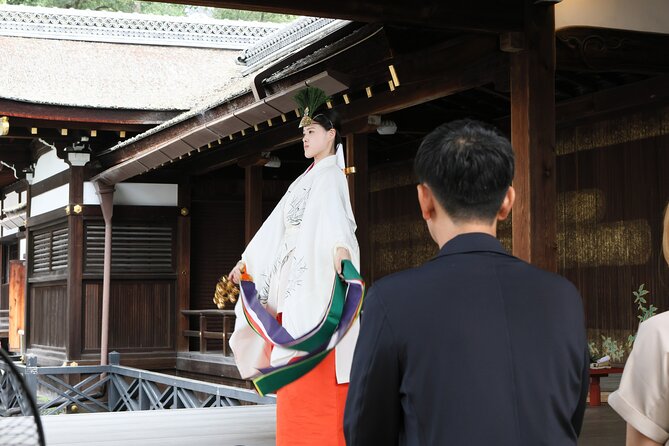
As visitors approach the iconic vermilion torii gates that mark the entrance to Fushimi Inari Taisha, they’ll be struck by the sheer scale and grandeur of the shrine grounds.
The main pathway, known as Senbon Torii, is flanked by thousands of vibrant red torii gates that wind up the densely forested mountain.
Navigating this network of trails and staircases can be daunting, but helpful signage and maps are available.
Along the way, visitors will encounter numerous smaller shrines, peaceful rest areas, and vantage points offering stunning views of Kyoto.
With a local guide, the experience becomes seamless and insightful.
Offerings and Symbolic Gestures
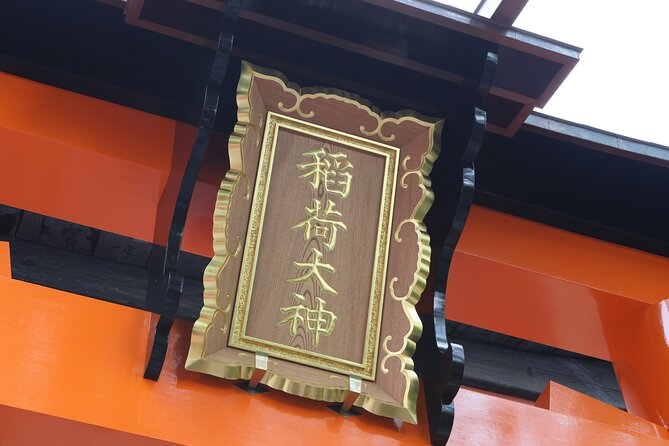
Visitors enjoy the rich symbolism of Fushimi Inari Taisha through various offerings and gestures. They can withdraw and offer Shinto signs, write prayers on ema wooden plaques, and participate in a Kagura ritual led by a Shinto priest.
These meaningful acts connect visitors to the shrine’s spiritual essence. The guide provides insights into the significance of each activity, enhancing the experience.
Visitors feel a deep sense of connection as they engage in these time-honored traditions, leaving with a greater understanding of Shinto beliefs and practices.
Photographic Opportunities
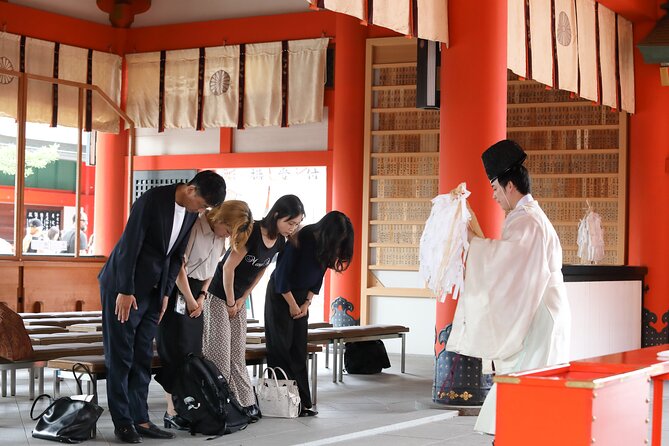
Throughout the experience, visitors can capture stunning photographs that immortalize their journey at Fushimi Inari Taisha. The iconic torii gates, winding paths, and serene shrines provide ample opportunities for evocative shots.
Visitors can frame the vermilion gates against lush greenery or snap photos of the intricate Shinto rituals. The photo download service included in the experience allows guests to easily access and preserve their memories.
With the guidance of the interpreter, visitors can learn about the cultural significance of the shrine and incorporate it into their photography. The photographic possibilities are endless, making this a truly memorable experience.
Practical Considerations
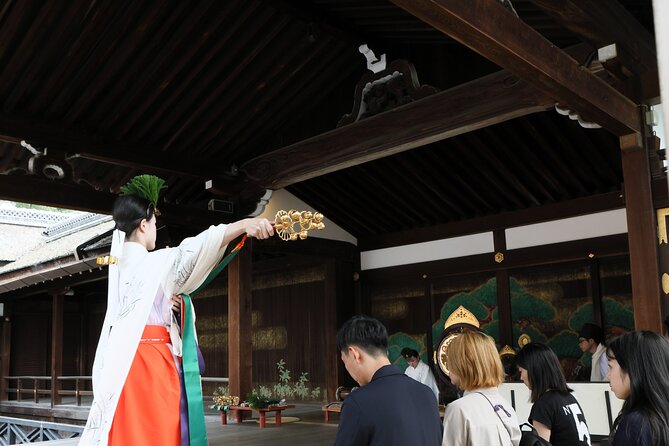
Although the Fushimi Inari Taisha experience is wheelchair and stroller accessible, visitors should avoid bringing large luggage, as the shrine’s narrow paths and steep climbs may prove challenging. The meeting and end points are conveniently located near public transportation. To ensure a smooth experience, visitors are advised to confirm the experience time with the local provider in advance and take advantage of the baggage storage service.
| Considerations | Recommendations |
|---|---|
| Luggage | Avoid large luggage |
| Accessibility | Wheelchair and stroller accessible |
| Transportation | Near public transportation |
Frequently Asked Questions
Can I Participate if I’m Not a Shinto Practitioner?
Yes, you can participate in the Fushimi Inari Taisha Prayer and Kagura Experience even if you’re not a Shinto practitioner. The experience is open to all visitors and provides an opportunity to learn about Shinto customs and rituals.
Is It Possible to Visit the Shrine Independently After the Tour?
Yes, you can visit the Fushimi Inari Shrine independently after the tour. The shrine is open to the public, and visitors are free to explore the iconic torii gates and hiking trails on their own.
Can I Purchase Souvenirs or Make Additional Offerings During the Experience?
Visitors can purchase souvenirs and make additional offerings during the experience. The tour includes articles to be withdrawn/offered, so participants have the opportunity to make personal offerings at the shrine.
What Should I Wear for the Prayer and Kagura Performance?
For the prayer and kagura performance, it’s best to wear neat, modest attire. Avoid shorts, sleeveless tops, and sandals. Comfortable walking shoes are recommended as there’s some walking involved.
Is There an Age Limit or Special Accommodations for Children?
There’s no age limit, and children are welcome. The experience is wheelchair and stroller accessible. Families should avoid bringing large luggage to ensure smooth participation.
The Sum Up
The Fushimi Inari Taisha’s Prayer and Kagura Experience offers visitors a unique chance to explore Shinto traditions. Guided by a priest, participants engage in purification rituals and witness the captivating Kagura performance, fostering a deeper understanding of Japan’s rich religious heritage. This immersive experience leaves a lasting impression, encouraging visitors to further explore Fushimi Inari Taisha’s sacred grounds and uncover the shrine’s profound spiritual significance.
More Tour Reviews in Kyoto
- Kyoto: Discover Every Bit of Ginkakuji Temple in 60 Minutes
- Private Full-Day Walking Tour of Kyoto
- Hidden Temples in Kyoto a Self-Guided Zen Tour
- 2 Hour Private Tour of Arashiyama Highlights
- Nara 9hr Tour Licensed Guide&Vehicle: Kyoto Pickup/Osaka Dropoff
- Kyoto: Half-Day Private Tour Gion Geisha Districts & Kiyomizu
Not for you? Here's more nearby things to do in Kyoto we have reviewed
- Kyoto: Discover Every Bit of Ginkakuji Temple in 60 Minutes
- Private Full-Day Walking Tour of Kyoto
- Hidden Temples in Kyoto a Self-Guided Zen Tour
- 2 Hour Private Tour of Arashiyama Highlights
- One Way Bus From Kanazawa to Kyoto
- Nara 9hr Tour Licensed Guide&Vehicle: Kyoto Pickup/Osaka Dropoff
- Original Pizza Making Using Kyoto Vegetable at BNR Night Farm
- Kyoto 8 Hr Tour From Osaka: English Speaking Driver, No Guide
- Kyoto: Half-Day Private Tour Gion Geisha Districts & Kiyomizu
- Kyoto Sweets & Desserts Tour With a Local Foodie: Private & Custom
- Arashiyama Autumn Leaves & Sanzen-In Temple Tour From Osaka/Kyoto
- Kyoto: Top Sake Region Tour – 2.5 Hours, 3 Tasting Spots
